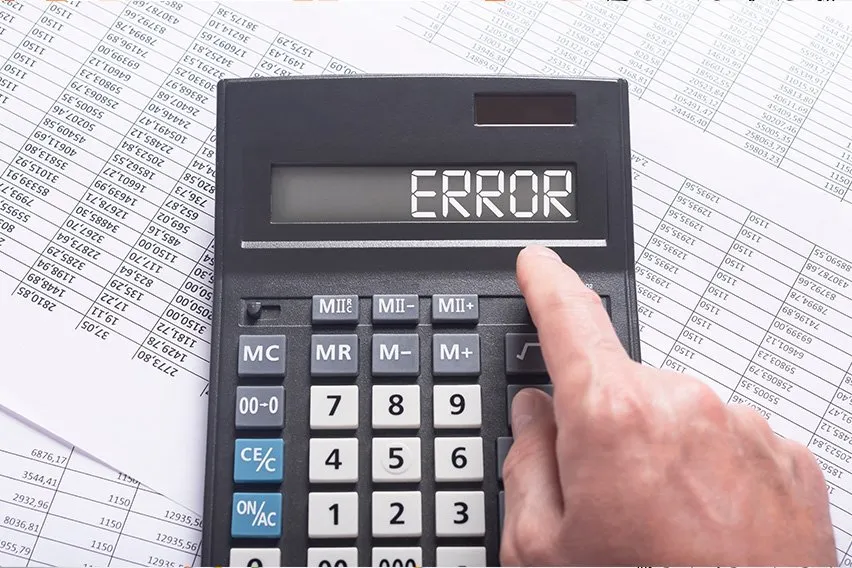Types of Errors in Accounting: A Guide for Small Businesses

There are several different types of errors in accounting. Accounting errors are usually unintentional mistakes made when recording journal entries.
Small accounting errors may not affect the final numbers in financial statements. Or they might cause major distortions in the overall figures. These types of errors require lots of time and resources to find and correct them.
Since accounting errors can disrupt your business, every small business should know the most common types of accounting errors so it’s easier to spot and correct them.
In this article, we’ll cover:
- Subsidiary Entries
- Error of Omission
- Transposition Errors
- Rounding Errors
- Errors of Principle
- Errors of Reversal
- Errors of Commission

1. Subsidiary Entries
Subsidiary entries are transactions that aren’t recorded correctly. This mistake is only normally discovered during a bank reconciliation, according to The Balance.
- For example, an invoice is entered in accounts receivable as $10,000 instead of the $1000 actually owing.
How to find it: The trial balance won’t show this error. You’ll need to do a bank reconciliation i.e. check the numbers in your books against the numbers on your bank statement. It’s important to do this frequently. If you only do it every six months, for example, you’ll have to sift through six months of records to find the mistake.
2. Error of Omission
An error of omission happens when you forget to enter a transaction in the books. You may forget to enter an invoice you’ve paid or the sale of a service.
- For example, a copywriter buys a new business laptop but forgets to enter the purchase in the books.
How to find it: Errors of omission are hard to discover. One way to find them is to check if your credits equal your debits in your trial balance. You may have entered a credit for a transaction but no debit. Doing regular bank reconciliations will also help you double check your books for accuracy.
It’s better to act preventatively and have a system in place to enter each transaction. Errors of omission tend to crop up when a company uses petty cash to pay for expenses. Keep your receipts and paperwork and set up a regular time each week to enter the data.
3. Transposition Errors
When two digits are reversed (or “transposed”), an error is created in the books. It’s a simple error but it completely throws off your accounting.
- Example: “3563” instead of “5363.”
How to find it: Compare the totals in your trial balance with the totals in your bank statement. If the difference between the two totals is evenly divisible by nine, you probably have a transposition error on your hands, according to Old Dominion University.
4. Rounding Errors
Rounding a figure can make your accounting inaccurate and create a series of future errors. Either people or accounting software can make this mistake.
- For example, 23.965 instead of 23.9646
How to find it: A tiny mistake that can be easily fixed by reconciling your books regularly. Don’t let this mistake snowball–nip it in the bud by checking your bank statements against your books often.
5. Errors of Principle
A transaction that incorrectly uses an accounting principle is called an error of principle. Errors of principle don’t meet the generally accepted accounting principles (GAAP). It’s also called an “input error” because, though the number is correct, it’s recorded in the wrong account.
- For example, personal expenses are accidentally recorded as business expenses in the books
How to find it: This requires scanning the trial balance for potential errors, as debits and credits will probably still balance regardless of the mistake.
6. Errors of Reversal
When an entry is debited instead of being credited, or vice versa, this is an error of reversal.
- For example, a $500 invoice sent to a client is posted in accounts payable instead of accounts receivable
How to find it: Check your trial balance and find the difference between the credits and debits (they should match, or “balance”). Divide the difference by two and check your trial balance for that number. It could be in credits instead of debits, according to Old Dominion University.
7. Errors of Commission
An error of commission occurs when an amount is entered right and in the correct account but the value is wrong–i.e. it’s subtracted instead of added or vice versa.
- For example, a payment is applied to the wrong invoice. The amount owing by the client will still be correct in the trial balance, obscuring the mistake.
How to find it: The trial balance will look right but the client’s subledger (or entry details) will be off. The method used for errors of reversal can also be used to find the mistake.
People also ask:

What Are the Most Common Errors in Accounting?
The most common errors in accounting, according to the Houston Chronicle, are:
Errors of Omission
Not recording data is common, whether it’s not reporting expenses or not adjusting inventory quantities. Omitting data affects the balance sheet and can make a company look like it’s doing better than it actually is. It also creates problems when filing your small business taxes.
Data Entry Errors
Incorrectly entering data is another common mistake. The information from financial documents like an invoice isn’t entered correctly in the books. For example, $1000 can be entered instead of $100.
Data Classified Incorrectly
All data entries must be classified as assets (items owned) or liabilities (money owed). If an asset is accidentally entered as an expense (a type of liability), then it is said to be classified incorrectly. This error drastically affects the balance sheet and gives an incorrect picture of the business’s financial status.
Correcting Errors in Accounting
As soon as you spot an error, you should correct it in order to make sure your financial statements are accurate.
The best way to correct errors in accounting is to add a correcting entry. A correcting entry is a journal entry used to correct a previous mistake.
The type of correcting entry depends on:
- GAAP (generally accepted accounting practices) guidelines
- What financial period is affected
- How financial statements are affected
- If the error’s counterbalancing (balances out another error)
To correct an error, first ask yourself:
- What type of error is this?
- How should this have been entered?
- How can we use a correcting entry to fix this mistake?
Error Correction Example
A small painting company receives $500 from a client in payment for an invoice. The bookkeeper enters $50 in cash and $50 in accounts receivable instead. Cash is understated and accounts receivable is overstated.
Cash needs to be increased by $450 and accounts receivable needs to be reduced by $450. The correcting entry journal entry will debit cash by $450 and credit accounts receivable by $450 (debits increase amounts, credits reduce them).
RELATED ARTICLES

 What Is Product Cost?
What Is Product Cost? What Is Credit Risk? It’s the Ability to Repay a Loan
What Is Credit Risk? It’s the Ability to Repay a Loan What Are Standard Costs? They’re Estimates
What Are Standard Costs? They’re Estimates Discontinued Operations: Its Impact on Financial Reporting
Discontinued Operations: Its Impact on Financial Reporting Is Accounts Receivable an Asset?
Is Accounts Receivable an Asset? 6 Best Payroll Services for Small Businesses in 2024
6 Best Payroll Services for Small Businesses in 2024